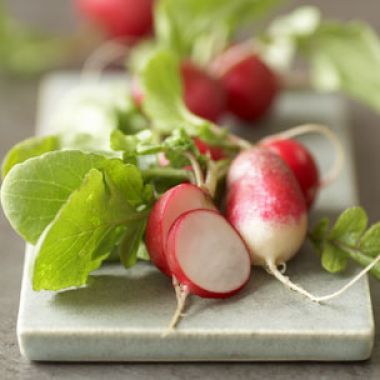
Although radishes come in a tremendous diversity of sizes, shapes and colors, they all belong to a single subspecies of the mustard family. Aside from the familiar round red radishes, there are thin white ones, known as icicle radishes; Easter egg radishes that range in color from purple and white to lavender and red; and deep red, elongated French breakfast radishes, which fade to white at the root. Central Europeans serve grated black radishes as a first course.
Although radishes are sometimes boiled, steamed or sautéed, their flavor and texture are perhaps best appreciated when raw. They are sliced and used to add color and crunch to salads. Spring radishes, accompanied with sweet butter and bread, are a classic French hors d'oeuvre.
In addition, several different Asian radishes exist, which are cooked, pickled or eaten raw. The most common is the daikon, a cylindrical vegetable that grows up to 20 inches long and about 2 inches in diameter. It is used extensively in Japanese cooking. Fried dishes are almost always accompanied by fresh daikon, as it is thought to aid the digestion of oily foods. It is grated and eaten in salads or pickled to eat with rice, and it turns up in long, thin threads on platters of sushi. The Chinese also use daikon, but they prefer to cook chunks of it in stews and other dishes.
Selecting
Look for smaller, round radishes in spring and elongated ones as summer arrives. Large Asian radishes are in season in autumn, and black radishes are in season in winter. Some more unusual varieties of radish are found in Asian groceries and farmers' markets. All radishes should be firm, with smooth skins and unwilted green leaves.
Storing
If you are planning to serve the radishes whole as an hors d'oeuvre, don't remove the leaves; serve the radishes within a day or two of purchase. Otherwise, remove the leaves before storing small radishes in a perforated bag in the refrigerator for up to 1 week. Large radishes such as daikon can be refrigerated for up to 2 weeks. Use the greens in salads or cook them like other greens.
Preparing
Scrub the radishes and trim both ends, unless you are serving them as an hors d'oeuvre, in which case you may want to trim the root end but leave 1 inch of the leaves.
Adapted from Williams-Sonoma Kitchen Companion: The A to Z Guide to Everyday Cooking, Equipment and Ingredients (Time-Life Books, 2000)













